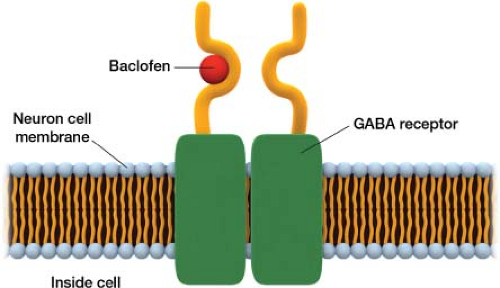Muscle Relaxants
Muscle relaxants are broadly classified into two categories: Those that act peripherally at the muscle itself and those that act in the central nervous system (CNS). Muscle relaxants that act peripherally work at the neuromuscular junction (where nerves and muscle fibers communicate) decreasing muscle tone and possibly causing paralysis. They are commonly used in surgery. An example of a peripherally acting muscle relaxant is succinylcholine. Peripherally acting muscle relaxants are beyond the scope of this book and rarely used in pain management.
Centrally acting muscle relaxants are used to reduce spasticity and alleviate pain caused by muscle spasm. Three of the most commonly used centrally acting muscle relaxants are Baclofen (Lioresal), Zanaflex (Tizanidine), and Flexeril (Cyclobenzaprine). Table 12-1 presents an overview of their methods of action.
Baclofen acts like the inhibitory neurotransmitter γ-aminobutyric acid (GABA). It decreases activity from central neural outputs, primarily in the spinal cord, that control the contraction of skeletal muscle. Some studies have shown that baclofen also has analgesic effects by decreasing the responsiveness of nociceptive (pain) neurons (Fig. 12-1).1
Table 12-1 Methods of Action of the Most Commonly Administered Centrally Acting Muscle Relaxants
Medication
Method of Action
Baclofen (Lioresal)
GABA agonist in the brain and spinal cord
Zanaflex (Tizanidine)
Centrally acting α2 adrenergic agonist that inhibits excitatory amino acid release from spinal interneurons
Flexeril (Cyclobenzaprine)
Structurally related to tricyclic antidepressants (TCAs). The mechanism of action is unknown but thought to decrease α-motor neuron firing in the brain stem
Zanaflex works as an agonist of the noradrenergic α2 receptor. By stimulating the α2 receptor, there is a
decrease in the release of excitatory neurotransmitters. This increases the effects of inhibitory interneurons on skeletal muscle contraction (Fig. 12-2).

Figure 12-2 Method of action of Zanaflex (Tizanidine) is to decrease excitatory neurotransmitters.
Stay updated, free articles. Join our Telegram channel

Full access? Get Clinical Tree

 Get Clinical Tree app for offline access
Get Clinical Tree app for offline access







